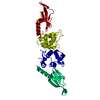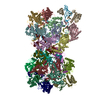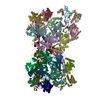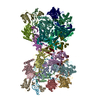+Search query
-Structure paper
| Title | Insights into the inhibition of type I-F CRISPR-Cas system by a multifunctional anti-CRISPR protein AcrIF24. |
|---|---|
| Journal, issue, pages | Nat Commun, Vol. 13, Issue 1, Page 1931, Year 2022 |
| Publish date | Apr 11, 2022 |
 Authors Authors | Lingguang Yang / Laixing Zhang / Peipei Yin / Hao Ding / Yu Xiao / Jianwei Zeng / Wenhe Wang / Huan Zhou / Qisheng Wang / Yi Zhang / Zeliang Chen / Maojun Yang / Yue Feng /  |
| PubMed Abstract | CRISPR-Cas systems are prokaryotic adaptive immune systems and phages use anti-CRISPR proteins (Acrs) to counteract these systems. Here, we report the structures of AcrIF24 and its complex with the ...CRISPR-Cas systems are prokaryotic adaptive immune systems and phages use anti-CRISPR proteins (Acrs) to counteract these systems. Here, we report the structures of AcrIF24 and its complex with the crRNA-guided surveillance (Csy) complex. The HTH motif of AcrIF24 can bind the Acr promoter region and repress its transcription, suggesting its role as an Aca gene in self-regulation. AcrIF24 forms a homodimer and further induces dimerization of the Csy complex. Apart from blocking the hybridization of target DNA to the crRNA, AcrIF24 also induces the binding of non-sequence-specific dsDNA to the Csy complex, similar to AcrIF9, although this binding seems to play a minor role in AcrIF24 inhibitory capacity. Further structural and biochemical studies of the Csy-AcrIF24-dsDNA complexes and of AcrIF24 mutants reveal that the HTH motif of AcrIF24 and the PAM recognition loop of the Csy complex are structural elements essential for this non-specific dsDNA binding. Moreover, AcrIF24 and AcrIF9 display distinct characteristics in inducing non-specific DNA binding. Together, our findings highlight a multifunctional Acr and suggest potential wide distribution of Acr-induced non-specific DNA binding. |
 External links External links |  Nat Commun / Nat Commun /  PubMed:35411005 / PubMed:35411005 /  PubMed Central PubMed Central |
| Methods | EM (single particle) / X-ray diffraction |
| Resolution | 2.1 - 3.2 Å |
| Structure data | EMDB-31185, PDB-7elm: EMDB-31186, PDB-7eln:  EMDB-32387: Csy1 region of the Csy-AcrIF24-dsDNA(non-sequence-specific) complex EMDB-32440, PDB-7we6:  PDB-7dtr: |
| Chemicals |  ChemComp-HOH: |
| Source |
|
 Keywords Keywords | VIRAL PROTEIN / HTH motif / protein interaction / IMMUNE SYSTEM/RNA / complex / inhibitor / IMMUNE SYSTEM / IMMUNE SYSTEM-RNA complex / IMMUNE SYSTEM/RNA/DNA / IMMUNE SYSTEM-RNA-DNA complex |
 Movie
Movie Controller
Controller Structure viewers
Structure viewers About Yorodumi Papers
About Yorodumi Papers










